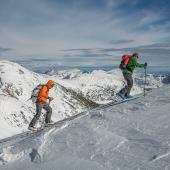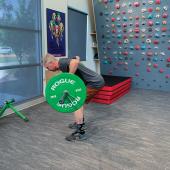Shoulder Exercises
After a long break from shoulder-intensive sports, many southwest Montana outdoor sports enthusiasts will soon transition into kayaking, golfing, climbing, Frisbee golf, and other sports involving overhead or raised-arm motions. Spring is an ideal time for shoulder re-conditioning in preparation for these activities. A conservative regimen of shoulder stabilization exercises is a great way to enhance your sports performance and reduce the likelihood of injury.
Proper conditioning of the shoulder includes a progression of exercises, beginning with increasing the strength and endurance of the rotator cuff muscles and scapular stabilizers. Strengthening of the much larger and more powerful deltoid group should be left until the advanced phases of conditioning, due to the great mechanical advantage it has on the position of the glenohumeral (ball-and-socket) joint. Concentrate your conditioning efforts on the smaller muscles of the shoulder—first by isolating them in their normal range of motion, then by integrating them in dynamic stability exercises such as the ones described below.
Dynamic stabilization exercises for the shoulder complex can be performed with a variety of exercise equipment or none at all. Again, progression is the key to successful training—begin with simple exercises, and then challenge yourself by adding new training tools to your workout.
The following exercises can be incorporated into your existing workout.
- The Inchworm uses body weight only, and is a great example of a dynamic shoulder stabilization exercise that engages your core musculature. Begin with both feet on the floor, then bend over and place both hands on the floor directly in front of your feet. Keeping your feet in place, walk your hands out in front of you (on the floor) until you are in a basic push-up position. With hands on the floor, walk your feet back toward your hands until you’re in your original starting position.
- The BOSU Multi-Directional Tilt is another shoulder-stabilizing exercise using a BOSU ball or “dome”. With the flat surface side of the dome facing upwards, place your hands on each edge with thumbs inside the wells. Lift your body into a push up position on knees or toes. Slowly tilt the front of the dome, first away from you and then toward you. You should feel your “core” engage. Bring the dome back to center position. Maintain the push up position, but this time tilt the dome slowly to the right and then slowly left. Keep your hips as square to the floor as possible as not to allow for external hip rotation. Also, be sure that you’re not rocking the dome with your entire body—the movement should be initiated from the upper body. When you feel confident with the exercise you can mix up the direction patterns.
- The One-Arm Row can be performed by yourself or with a partner, using a variety of equipment. This example uses rubber tubing with handles attached to each end. Have your partner hold one end of the tubing (alternatively, attach it to a fixed object such as a doorjamb) while you hold the other end with one hand. Move apart until the desired resistance is obtained. Stabilize your shoulder by placing it back and down into a “locked-in-socket” position. Facing in-line with the tubing, extend your arm forward without over-reaching from your shoulder joint and pull your elbow back and in toward your rib cage, creating a rowing motion. Be sure your handgrip is relaxed but secure so that your forearm and biceps do not over work. Perform 12-15 reps; repeat on the opposite side.
- The Balance Overhead Press is a combined core- and shoulder-stabilizing exercise. Begin by holding one dumbbell (conservative weight) in your right hand. Keep in mind that even the lightest weight can be challenging. Bring your right hand up to shoulder height, directly out to your side with your palm facing forward. Place your left hand on your hip and lift your right foot 2-3 inches from the floor. You should now be balancing on your left foot. Maintain that position and begin doing slow, controlled overhead presses with your right arm. Perform 12 repetitions and move to opposite side, dumbbell in left hand while balancing on right foot. Increase the challenge by using a balance cushion under your foot.
- The Plank may be performed with no equipment. Lie on the floor face-down. Prop yourself on your elbows making sure that they are directly under your shoulders. Begin be lifting your hips from the floor and then lift your knees so that you are balancing on your toes and elbows. Be sure that your head is lifted to create a straight line from the top of your head down to your heels. You should feel your shoulders stabilizing your upper body while your core engages to keep your center (abdominal area) from sagging toward the floor. Once you’ve accomplished this first progression, you can then begin practicing arm movement and balance by maintaining your upper body on one elbow and extending your opposite arm out and lengthened past your head. Slowly change arms for 4-8 repetitions.










